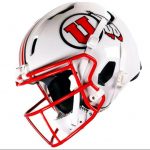
In this ongoing series, we are sharing advice, tips and insights from real entrepreneurs who are out there doing business battle on a daily basis. (Answers have been edited and condensed for clarity.)
Whether you are glued to RedZone on Sundays or are a casual fan, one fact about today’s NFL game is hard to miss: concussions are a serious problem. In the 2022 season, brain injuries suffered by players on the field were up by 18 percent.
Enter LIGHT Helmets, a disrupter in the protective headgear industry that has utilized materials used in the helmets of military special operators and aviators, as well as professional auto racers, to develop the lightest football helmet on the market. They weigh just 3 pounds, 13 ounces, as opposed to more traditional helmets that can weigh up to 6 pounds, which begs the question: How does a lighter helmet provide better protection? “In simple terms, the reduction in the mass of the helmet reduces its kinetic energy when a tackled player’s head meets an immovable object — the field,” says LIGHT CEO Nick Esayian. “So you’re not hitting the back of your head with nearly as much velocity. Added bonus: taking two pounds off the gear you’re playing in gives you that competitive edge to be faster out there.”
We spoke with Esayian to discuss the company’s origin, how it managed to break into the walled-off world of the NFL, and its game plan for future dominance at the pro, college and youth levels. To hear more, check out his LIGHT Impact podcast, where Esayian interviews sports, military and business leaders about the success mindset.
How it all started
I was first introduced to Bill Simpson of Simpson Racing at the paddock at the Long Beach Grand Prix. He built and sold Simpson Racing and another company called Impact Racing that made protective equipment. He was working on a football helmet company with former race car great Chip Ganassi. They had helmets on Dwight Freeney and Jeff Saturday in the NFL, but they just couldn’t get it to grow. Bill had been in an NFL owners’ meeting and they weren’t interested. So, using some colorful language that basically told them to go to hell, he walked out. He said to me, “Listen, I don’t want this concept to die, but I’m getting too old to push it forward. Do you want to, do you want to give it a run?” So through a confluence of events, we took ownership of the assets at the end of 2018. We quickly spun it up, got a proof of concept, and sold a couple thousand helmets.
Rough Trade
Things were looking great. We had investors lined up — First Trust Bank, Richard Green who is part owner of the Philadelphia Eagles — and then the pandemic hit and the market tanked. Now, I was tempted to roll around on the floor with a bottle of whiskey, but we regrouped. We found twelve of the leading neurologists and trauma doctors, like Michael McDermott, who runs Baptist Health in Florida, Peter Cummins, who runs TB12 for Tom Brady and Tal David, who was a Chargers lead physician. We had them work with our engineers here in San Diego. San Diego is home to about half of the Navy SEALs, so we were able to combine military and auto-racing tech with this helmet. Now, we obviously didn’t sell anything during the pandemic, but once we came out of it, our product was so strong that we made about $2,000,000 in revenue and ran out of inventory.
The science of lightness
Our helmets weigh three pounds. Our competitors’ helmets weigh five to six pounds. You see players getting concussed over and over, and it’s not about head-to-head collisions. Those kinds of hits are not gone entirely, but they’re greatly reduced because of rule changes. These concussions have a lot to do with heads hitting the ground, all of that energy hitting an immovable object — which is the earth. So by reducing the weight of the helmet, we’re reducing the kinetic energy and that secondary impact. The energy equation is half the mass times the velocity squared. So If I reduce the mass by 50%, I’m in essence reducing that kinetic energy of my head hitting the ground.
Barriers to entry
We’ve got some neat people involved in this, including Jordan Palmer, who’s Carson Palmer’s brother. Jordan is kind of the quarterback whisperer who privately coaches guys like Josh Allen, Trevor Lawrence and Joe Burrow. So we’ve got him, Navy SEALs, scientists and all of these pieces lined up where we’re right at the precipice of this becoming a very visible company. We’re in 14 NFL locker rooms, in 20 college locker rooms and a couple hundred high school locker rooms. But having said all of that, the barriers to entry in this space are huge. For the NFL, there is a litmus test that you have to go through. They hire a consultant who has a kind of a “living test” that changes slightly as they learn more about the product and injuries. And if you pass that hurdle, which is very difficult — there may only be 15 models of helmets that pass that test — then each individual equipment manager for each franchise will make their own determination. Do they want to bring that vendor and that model into their locker room? If they do, then your helmet goes on a helmet tree, which looks like a Christmas tree. And the players come in when they’re going to start the season and choose what they want. Colleges and high schools don’t have those kinds of tests. They look to the NFL and also continuing research done by Virginia Tech, which is like the Consumer Reports for helmets. And if it meets their criteria, they’ll buy.
The Big Game Plan
The total addressable market is about 5 million players in the United States — just over 6 million globally. Right now we’re the smallest in the field, but there are only four competitors: Riddell, Schutt (who also owns Vicis), Xenith and LIGHT. By the end of this year, I am very confident that we’ll be number three and by the end of 2025, we’ll be number two.
Our next target is going to be hockey space. If you look at a game from the 1980s you’ll see that not much has changed. And these advanced materials we’re using can also expand into lacrosse, flag football — any game that requires protective headgear. Now take one step away from sports and you have the construction helmet space. You’ve got a guy driving a $100,000 Ford Raptor, he’s got a $200 Snap-on hammer, and he’s wearing a $15 plastic construction helmet. Now, there are 25 million construction helmets sold a year, globally. It’s a huge market. And what do construction guys watch? Football, hockey, lacrosse. So if I can build a brand in football, which is the most scrutinized helmet on the planet, and I can win the day there? The possibilities are truly massive.
Pep Talk
I think anybody looking to take the leap into entrepreneurship has to have a lot of grit. I mean, you have to be crazy enough to try something like this and smart enough to make it work. That’s number one. Number two, you need to have the wisdom and the resilience to step back and reassess. There is a great Jocko Willink phrase that I think about a lot when it comes to problem-solving: Take a step back, detach from your emotional reaction, find out what is really going on, and then make calm, logical decisions based on the reality of the situation. Remember, if this were easy, everyone would do it. You’re trying to do something that no one else has done. And when you are not just trying to make money, but following a true passion and wanting to do good in the world? You’re unstoppable.
To read the full article, Click Here




